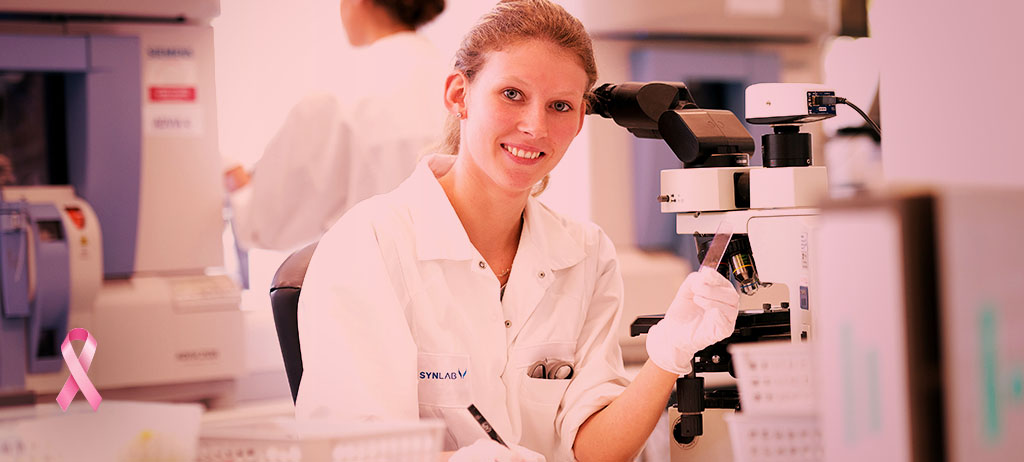Preeclampsia: the importance of screening with validated biomarkers and algorithms
Preeclampsia is one of the most significant hypertensive disorders of…
Continue reading


Breast cancer is one of the most prevalent neoplasms among women worldwide, significantly contributing to cases of disease and mortality. This pathology can present with different subtypes and degrees of aggressiveness, making its diagnosis and treatment challenging.
Advances in genomic medicine and early diagnostic techniques have enabled more precise and personalized interventions, resulting in higher chances of cure and a more favorable prognosis for patients.
Understanding risk factors, molecular markers, and new therapeutic approaches is essential in the fight against breast cancer.
According to the National Cancer Institute (INCA), breast cancer is defined as a disease where breast cells multiply in a disordered manner, forming a tumor with the potential to invade other organs.
Breast cancer can be classified into different types, depending on the characteristics of the tumor cells and the degree of spread. Early detection is crucial to increasing the chances of successful treatment.
Women are predominantly affected, and incidence increases with age. More than 80% of breast cancers are diagnosed in women over the age of 50. Breast cancer is the leading cause of cancer deaths, with 685,000 deaths worldwide in 2020 (1).
Breast cancer usually presents as a lump in the breast and is generally painless. However, 90% of breast masses are benign, such as fibroadenomas, cysts, and fibrocystic changes (1).
Breast cancers may present as:
Although extremely common, isolated breast pain without other signs is rarely a presentation of breast cancer (2).
The diagnosis of breast cancer involves a combination of clinical, imaging, and laboratory tests, which help identify changes in breast tissue.
Among the main ones, we can mention:
These tests, when combined, allow for an accurate diagnosis, enabling early detection of the disease, which is essential for treatment success.
With advances in scientific discoveries, knowledge about breast cancer has evolved significantly. Today, it is known that this is a complex and heterogeneous disease, characterized by multiple molecular alterations (4), in addition to epigenetic (5) and transcriptional factors involving numerous genes and proteins.
Despite this complexity, breast cancer can be detected early, and in this context, diagnostic tools have been rapidly developed and improved.
In addition to known risk factors such as smoking, alcohol consumption, obesity, and sedentary lifestyle (6), genetic factors (7) are also closely related to the predisposition to breast cancer.
Molecular markers are already used for diagnosis, prognosis, and prevention of breast cancer. Therefore, it is undeniable that, although immutable, genetic factors should be monitored, as they play a crucial role in clinical decision-making.
In this context, molecular tests have emerged as important tools for diagnosis and defining therapeutic guidelines (8).
Tumor characterization, including tumor size, intrinsic subtype, and number of affected lymph nodes, is essential for diagnosis and prognosis (4).
Intrinsic subtypes, which are closely related to breast cancer prognosis, show differences in gene expression profiles and survival rates, regardless of the recurrence time (4).
Breast cancer treatment does not always follow strict guidelines due to the complexity and heterogeneity of the disease. The choice of treatment depends on several factors, such as the type of cancer (invasive or non-invasive), aggressiveness, family history, and the patient’s genetic profile (9). The level of response to treatment is also highly individualized.
New studies and updates in prevention and diagnostic tools help define treatment strategies, which may include surgical procedures, chemotherapy, radiotherapy, and hormonal therapies (10). The characterization of the patient’s genetic profile and the tumor subtype is also crucial for treatment success.
In addition to its important contribution to diagnosis and prognosis, knowing the molecular profile of the tumor is fundamental for strategic planning in breast cancer control and early detection, increasing the chances of treatment success.
Early diagnosis of breast cancer is extremely important because it significantly increases the chances of cure and survival. When the disease is detected in its early stages, treatment options are more effective and less aggressive, potentially reducing the need for complex interventions such as chemotherapy or mastectomy.
Additionally, early detection allows for the identification of smaller tumors that are less likely to spread (metastasis), resulting in better prognoses for patients.
With advances in imaging technologies and molecular tests, accurate diagnosis in the early stages of breast cancer has become a reality, enabling personalized treatment and improving the quality of life for women affected by the disease.
However, in the era of personalized medicine, traditional biomarkers, such as tumor size and grade and the presence of lymph node metastases, are no longer sufficient for optimal management of patients in the early stages (11, 12). The incorporation of new molecular biomarkers is essential to optimize treatment and offer more individualized approaches.
Recent research has focused on the discovery and validation of molecular biomarkers that serve as prognostic and predictive tools, using multiparameter, multianalytic, and multigene tests already recommended by specialists in clinical practice.
Among the available biomarkers, the estrogen receptor (ER) is the most relevant for breast cancer. All newly diagnosed patients should undergo evaluation of this marker, which has both prognostic and predictive value, especially in endocrine therapy.
ER is associated with estrogen-mediated cancer cell growth, activating regulatory genes such as cyclin D and MYC (13). Thus, the level of ER can indicate the efficacy of antiestrogen therapy, which is essential for treatment (14).
Therefore, the earlier an invasive tumor is detected and treatment begins, the greater the likelihood of cure. With the advent of genomic medicine, early detection and characterization of breast cancer have become more accessible, and they are crucial in the fight against the disease.
In breast cancer prevention, vigilance is a key ally, as symptoms often go unnoticed. Many women diagnosed were asymptomatic at the time of diagnosis.
To prevent the disease, it is possible to avoid risk factors such as smoking and excessive alcohol consumption, and adopt habits such as weight control, physical activity, breastfeeding, and appropriate hormone therapy (15).
Additionally, practicing self-exams and regular consultations with specialist doctors remain fundamental for early detection and better prognoses. Physical changes such as secretions, skin irritation, and breast lumps are important signs to watch for.
The presence of a family history of cancer is a strong indicator for investigating molecular markers. Although genetic factors are immutable, monitoring the genetic profile is a promising tool in the fight against breast cancer.
SYNLAB offers comprehensive and innovative tests for women’s health, helping in the prevention and fight against breast cancer. Additionally, here on the blog, we have already covered other details about genetic tests for hereditary breast and ovarian cancer.
Working alongside women and healthcare professionals in the fight against breast cancer, SYNLAB has developed the Prosigna (PAM50) test, a molecular test that analyzes the expression of 50 genes and classifies the tumor into one of four intrinsic biological subtypes: Luminal A, Luminal B, HER2-enriched, and Basal.
The test also provides the Risk-Of-Recurrence (ROR) for the patient, based on three factors: tumor size, intrinsic molecular subtype, and tumor proliferation status.
In this regard, the Prosigna (PAM50) test, together with personalized genomic medicine, stands out as an important ally in the fight against breast cancer.
Important international guidelines (NCCN, ASCO, ESMO), which set the standards for breast cancer diagnosis and treatment, include intrinsic subtype classification as an essential parameter for selecting systemic therapy (16, 17).
The test is indicated for postmenopausal women who have undergone mastectomy due to breast cancer and who meet the following criteria:
Additionally, the Prosigna test offers:
Performing precise and up-to-date tests is essential for more accurate diagnoses and better treatment guidance. SYNLAB is here to help.
We offer diagnostic solutions with rigorous quality control to the companies, patients, and doctors we serve. We have been in Brazil for over 10 years, operate in 36 countries and three continents, and are leaders in service provision in Europe.
Contact the SYNLAB team and discover the available tests.
1) World Health Organization. Breast cancer. 2021. https://www.who.int/news-room/fact-sheets/detail/breast-cancer
2) Fonseca MM, Lamb LR, Verma R et al. Breast pain and cancer: should we continue to work-up isolated breast pain? Breast Cancer Res Treat. 2019;177(3):619–627.
3) Royal College of Radiologists. Guidance on screening and symptomatic breast imaging, fourth edition. 2019. https://www.rcr.ac.uk/system/files/publication/field_publication_files/bfcr199-guidance-on-screening-and-symptomatic-breast-imaging.pdf
4) Odle TG. Precision Medicine in Breast Cancer. Radiol Technol. 2017 Mar;88(4):401M-421M.
5) Godone RLN, et al. Clinical and molecular aspects of breast cancer: Targets and therapies. Biomed Pharmacother. 2018. PMID: 29945114 Review.
6) https://www.inca.gov.br/sites/ufu.sti.inca.local/files//media/document//a_situacao_ca_mama_brasil_2019.pdf
7) Renfro LA, et al. Precision oncology: A new era of cancer clinical trials. Cancer Lett. 2017. PMID: 26987624
8) Torsten Nielsen, Brett Wallden, Carl Schaper, Sean Ferree, Shuzhen Liu, et al. Analytical validation of the PAM50-based Prosigna Breast Cancer Prognostic Gene Signature Assay and nCounter Analysis System using formalin-fixed paraffin-embedded breast tumor specimens. BMC Cancer. 2014 Mar 13:14:177.
9) American Cancer Society. Treating Breast Cancer. Disponível em: https://www.cancer.org/cancer/types/breast-cancer/treatment.html
10) American Cancer Society. Breast Cancer Early Detection and Diagnosis. Disponível em: https://www.cancer.org/cancer/types/breast-cancer/screening-tests-and-early-detection.html
11) M.J. Duffy, N. O’Donovan, E. McDermott, J. Crown. Validated biomarkers: The key to precision treatment in patients with breast cancer. The Breast, 29 (2016), pp. 192-201.
12) M.J. Duffy, E.W. McDermott, J. Crown. Use of multiparameter tests for identifying women with early breast cancer who do not need adjuvant chemotherapy.Clin. Chem., 63 (4) (2017), pp. 804-806.
13) J.S. Carroll. EJE PRIZE 2016: Mechanisms of oestrogen receptor (ER) gene regulation in breast cancer. Eur. J. Endocrinol., 175 (1) (2016), pp. R41-R49.
14) W.L. McGuire. Estrogen receptors in human breast cancer: an overview. Estrogen Receptor Hum. Breast Cancer (1975).
15) American Cancer Society. Lifestyle-related Breast Cancer Risk Factors. Disponível em: https://www.cancer.org/cancer/types/breast-cancer/risk-and-prevention/lifestyle-related-breast-cancer-risk-factors.html
16) American Society of Clinical Oncology. Disponível em: https://www.asco.org/
17) European Society For Medical Oncology. Disponível em: https://www.esmo.org/
Preeclampsia is one of the most significant hypertensive disorders of…
Continue reading
Women’s health is a broad concept that encompasses physical, mental,…
Continue reading
Pregnancy is a time of profound transformations in a woman’s…
Continue reading